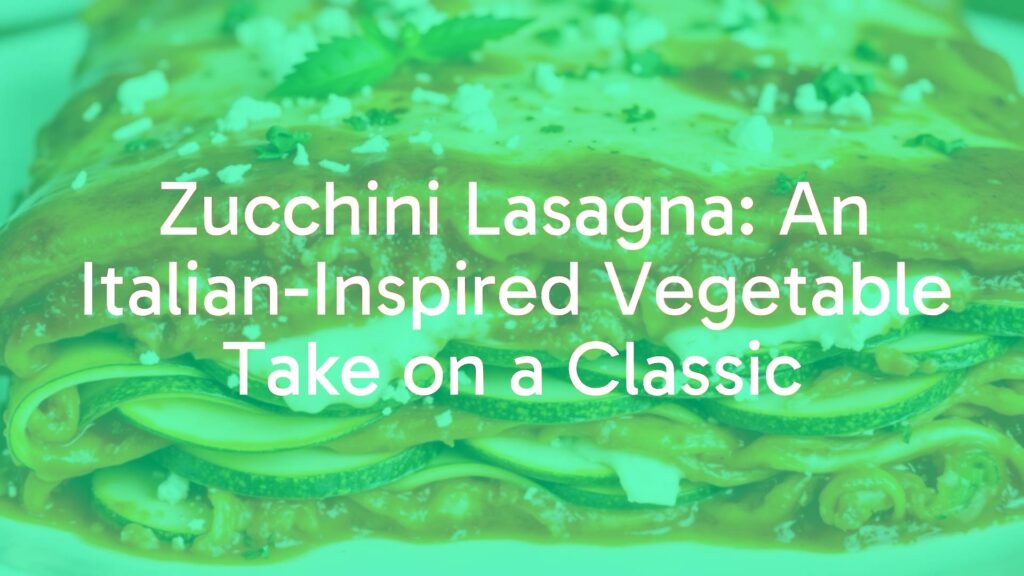Discovering Zucchini Lasagna
Zucchini lasagna is a contemporary interpretation of the classic Italian lasagna, replacing traditional pasta sheets with thinly sliced zucchini. This innovative dish preserves the rich, layered character of the original while offering a lighter, vegetable-forward alternative that appeals to a variety of dietary preferences. With its savory blend of cheese, sauce, and zucchini, it has gained popularity both in Italy and abroad as a flavorful and wholesome option.
Characteristics and Flavor Profile
Visually, zucchini lasagna is notable for its colourful layers: deep red tomato sauce, creamy white béchamel or ricotta, and vibrant green zucchini. The zucchini provides a delicate and slightly sweet flavor that contrasts beautifully with the robust notes of garlic, herbs, and cheese. Its cooked texture is tender yet holds its shape, making for a satisfying bite. The dish is typically less dense and lower in carbohydrates than traditional lasagna, offering a fresher, lighter feel while retaining the heartiness often associated with its inspiration.
Historical Background and Regional Connections
While classic lasagna originates in Emilia-Romagna, zucchini lasagna represents a more modern adaptation influenced by trends toward lighter, vegetable-based meals. It is particularly common in southern Italian regions such as Campania and Sicily, where zucchini is abundant during the warm months and often features prominently in local cooking. The dish’s emergence is also linked to broader Italian traditions of utilizing seasonal produce and adapting beloved recipes to contemporary tastes and nutritional needs.
Essential Components
The core of zucchini lasagna lies in its layering technique. Key ingredients include:
- Thin strips or rounds of fresh zucchini, often pre-cooked to reduce moisture
- Rich tomato-based sauce, frequently flavored with garlic, onions, and aromatic herbs like basil or oregano
- Creamy cheeses such as ricotta, mozzarella, and Parmigiano-Reggiano
- Occasional use of béchamel sauce for added creaminess, especially in northern versions
Unlike traditional lasagna, pasta sheets are omitted entirely, allowing zucchini to serve as both the structural and visual centerpiece.
Variations and Ingredient Substitutions
Zucchini lasagna lends itself well to variation. In some recipes, grilled or roasted eggplant is incorporated alongside zucchini for additional depth. Meat-based versions may include layers of ground beef, pork, or turkey, echoing the classic ragù style. For a vegetarian twist, layers of spinach, mushrooms, or artichokes can be added, and vegan takes often substitute dairy-based cheese with plant-based versions.
When zucchini is unavailable, yellow squash or even thinly sliced sweet potatoes occasionally serve as alternative “noodle” layers. The tomato sauce can be spiced up with chili flakes or enriched with roasted peppers for a different flavor direction.
Serving Suggestions and Pairings
Zucchini lasagna is best served hot, allowing the layers to meld beautifully. It can be accompanied by a crisp green salad dressed with lemon and olive oil, or roasted vegetables to keep the meal light. For beverage pairings, a dry Italian white wine such as Pinot Grigio or a light red like a Dolcetto complements the dish’s gentle flavors. Crusty Italian bread is also a welcome addition, perfect for soaking up the flavorful juices and cheese.
Whether served as a family-style main course or as part of a festive Italian-themed spread, zucchini lasagna offers a wholesome and creative take on a much-loved classic, demonstrating the adaptability and enduring appeal of Italian cuisine.

